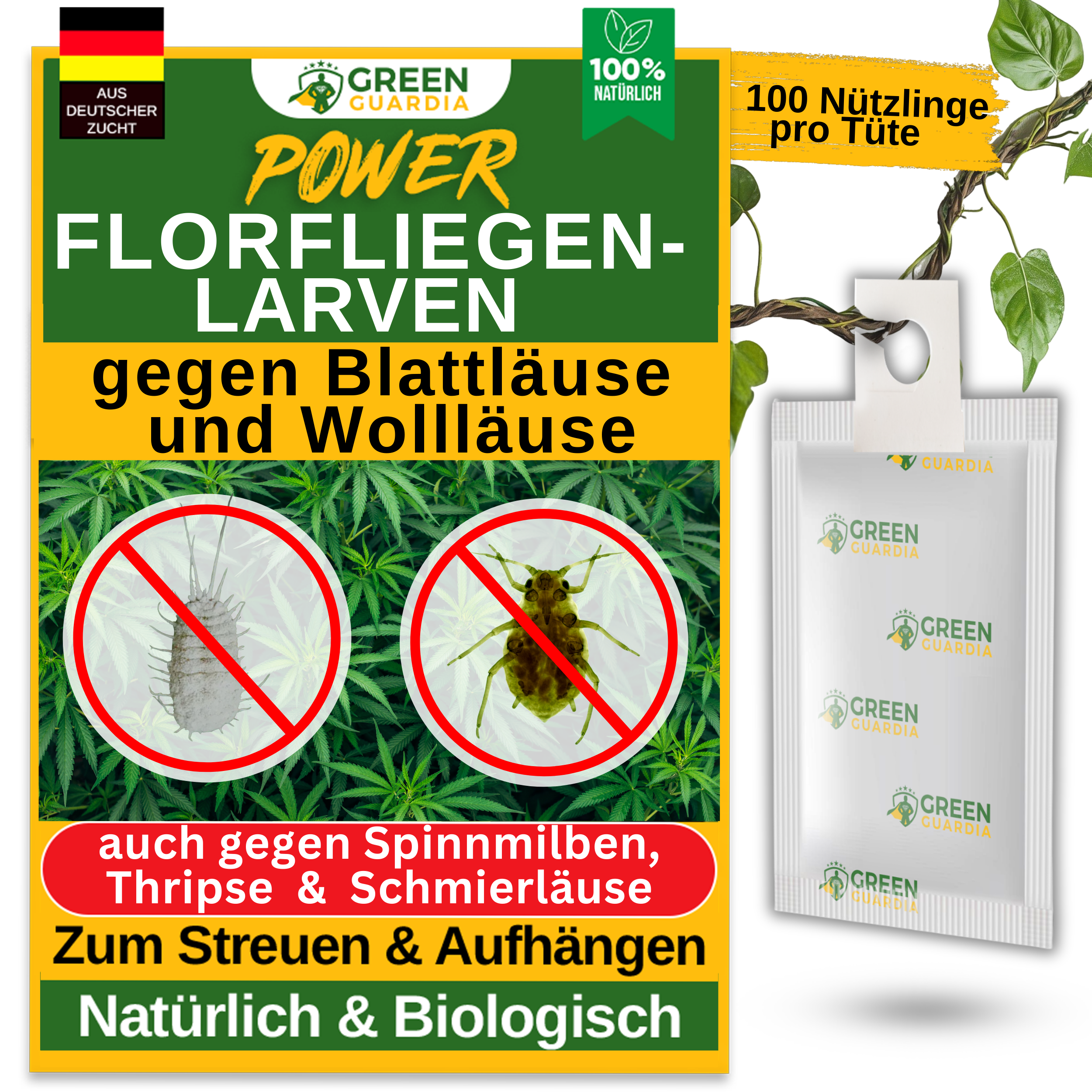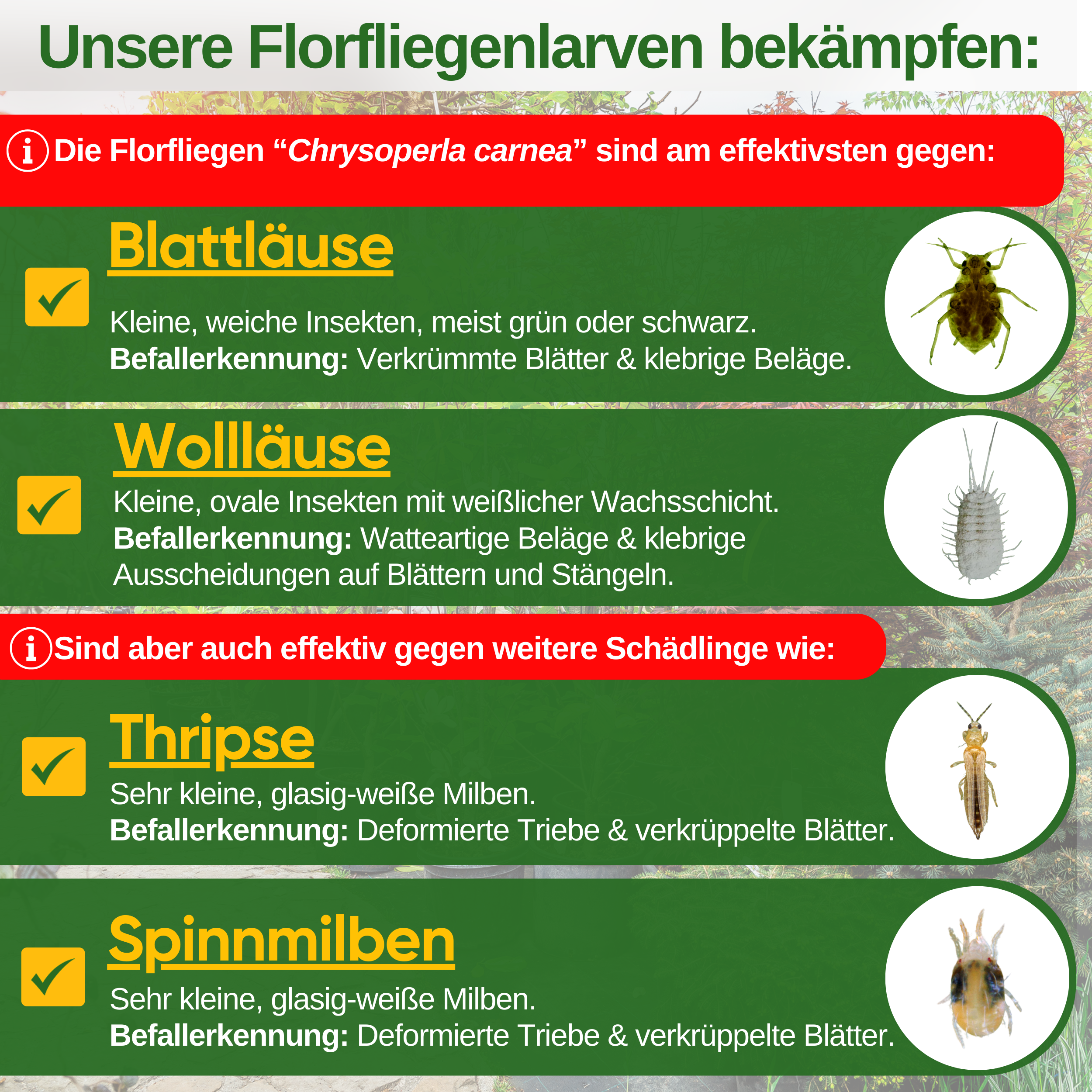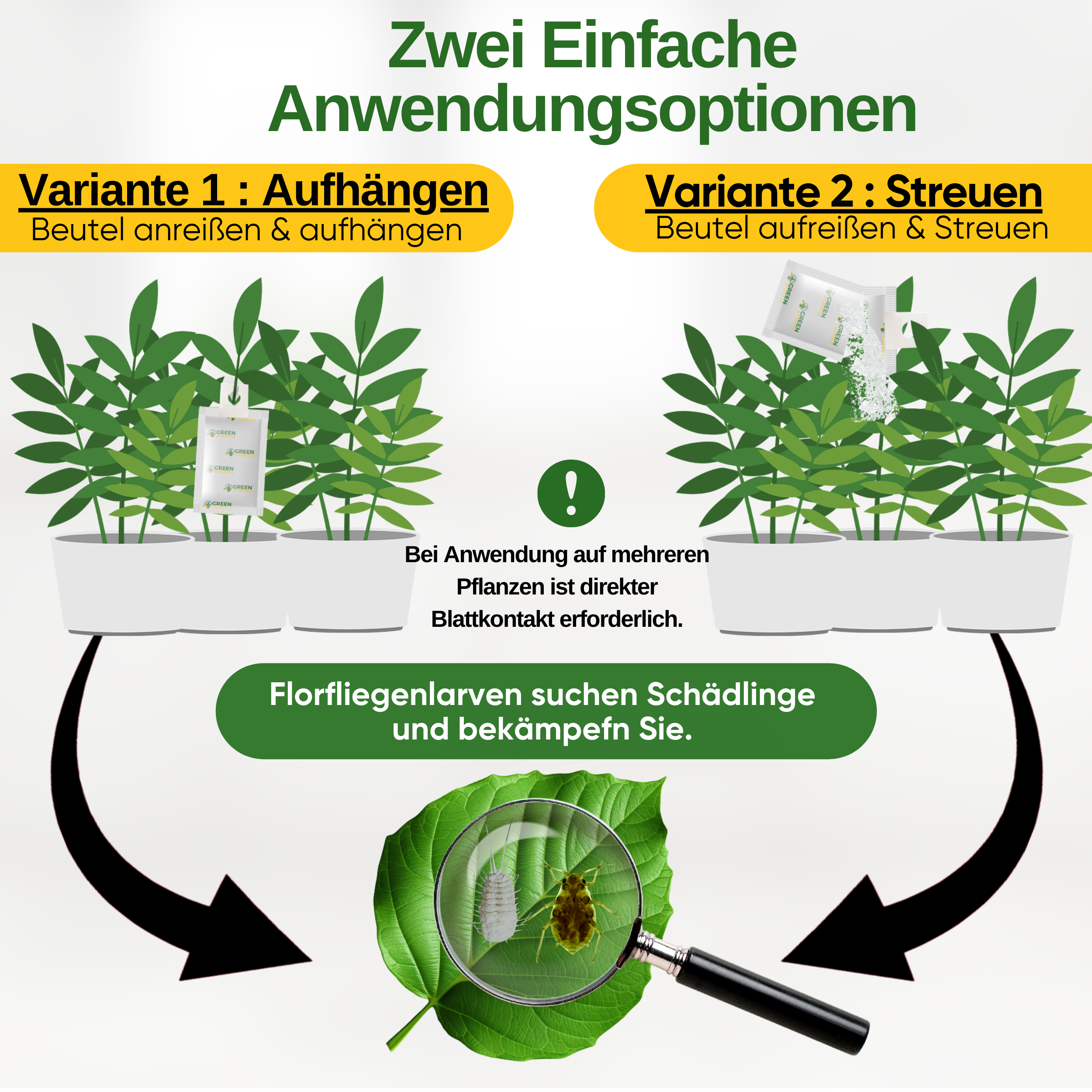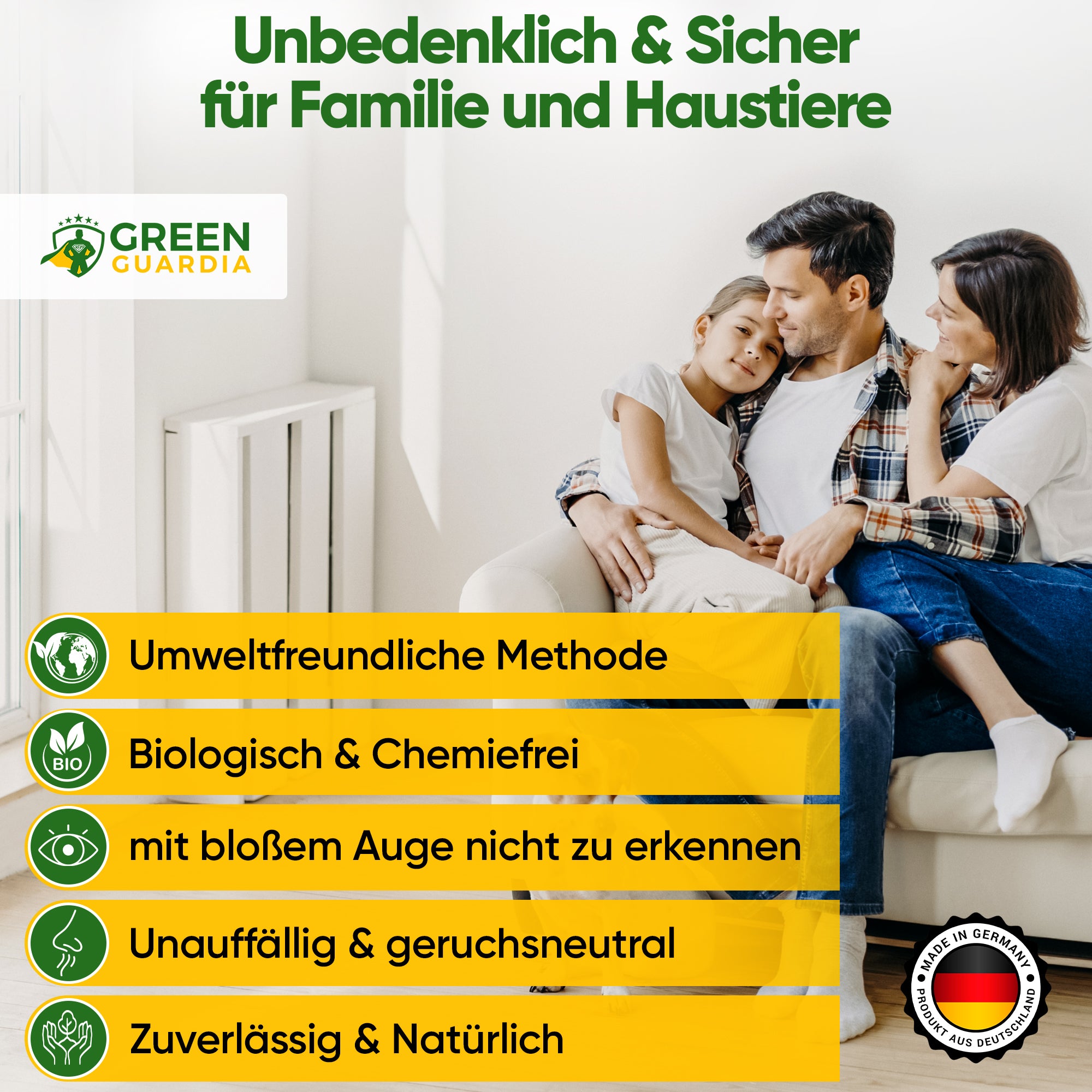
Number of bags







Lacewing larvae eggs against aphids, mealybugs for hanging or scattering
-
100% natural help for aphids & co.
-
From German breeding – delivered quickly
-
Completely chemical-free – no residues
-
Discreet, effective & biologically sustainable
-
Safe for children and pets
In stock - in 2-4 working days with you
Was unsere Kund*innen sagen
-
Wirksamkeit
nicht wirksam sehr wirksam -
Anwendung
kompliziert kinderleicht -
Verträglichkeit
bedenklich sehr sicher
Lieferoption wählen & clever sparen:



Choose options
-
100% natural help for aphids & co.
-
From German breeding – delivered quickly
-
Completely chemical-free – no residues
-
Discreet, effective & biologically sustainable
-
Safe for children and pets
In stock - in 2-4 working days with you
Was unsere Kund*innen sagen
-
Wirksamkeit
nicht wirksam sehr wirksam -
Anwendung
kompliziert kinderleicht -
Verträglichkeit
bedenklich sehr sicher
Lieferoption wählen & clever sparen:



-
100% natural help for aphids & co.
-
From German breeding – delivered quickly
-
Completely chemical-free – no residues
-
Discreet, effective & biologically sustainable
-
Safe for children and pets
In stock - in 2-4 working days with you
Was unsere Kund*innen sagen
-
Wirksamkeit
nicht wirksam sehr wirksam -
Anwendung
kompliziert kinderleicht -
Verträglichkeit
bedenklich sehr sicher
Lieferoption wählen & clever sparen:



GREEN GUARDIA Lacewing Larvae Eggs – Biological Pest Control for Hanging
GREEN GUARDIA Lacewing Larvae Eggs in Sachets are an effective, natural solution for controlling sucking pests such as aphids, thrips, spider mites , and scale insects . The tiny larvae hatch directly on the plant, hunt down pests, and reduce infestations – without any chemicals or residues.
It's incredibly easy to use: hang up the bags , create optimal conditions, and the "aphid lions" will do the work for you. Ideal for houseplants, balconies, greenhouses, or professional cultivation .
Application tips
- Temperature: At least 15 °C, optimally 20–26 °C for successful development of the larvae.
- No chemicals: Avoid using chemical products for at least 6 weeks before and during use.
- Remove ants: Ants protect aphids – they should be removed before use.
- Placement: Hang the bags directly on infested plants or near the source of the pest.
Areas of application for lacewing larvae
- Indoor and ornamental plants: Biological protection for indoor use – without residues.
- Cannabis crops: Safe use on sensitive plants – no impact on the harvest.
- Garden & Greenhouse: Sustainable protection against aphids and other pests outdoors.
- Agriculture & professional cultivation: Environmentally friendly alternative to chemicals.
🌿 Conclusion: GREEN GUARDIA lacewing larvae eggs for hanging are your natural, effective solution against a wide range of plant pests – easy to use, powerful in its effect and gentle on the environment.
Florfliegenlarven gegen Blattläuse & Co. – die clevere Nützlingslösung in Tüten
Blattläuse, Thripse, Spinnmilben und weitere Schädlinge können deinen Pflanzen erheblich zusetzen – ob im Haus, Garten, Gewächshaus oder auf dem Balkon. Die GREEN GUARDIA Florfliegenlarven in Aufhängetüten sind eine effektive, natürliche und chemiefreie Lösung zur gezielten Schädlingsbekämpfung.
Was macht Florfliegen so effektiv?
Florfliegenlarven gelten als extrem gefräßig – nicht umsonst werden sie auch "Blattlauslöwen" genannt. Bereits kurz nach dem Schlüpfen machen sie Jagd auf saugende Schädlinge und fressen diese zuverlässig auf. Die erwachsenen Tiere sorgen anschließend für die nächste Generation.
Florfliegeneier in Tüten – so funktioniert's
Jede Tüte enthält über 100 Florfliegeneier in verschiedenen Entwicklungsstadien. Innerhalb von ca. 2 Wochen schlüpfen die Larven, fressen Schädlinge und verschwinden rückstandsfrei nach getaner Arbeit.
- ✔️ Eine Tüte reicht für bis zu 10 m² Fläche
- ✔️ Perfekt für Zimmerpflanzen, Hochbeete, Gewächshaus & Garten
- ✔️ Biologisch, effektiv & vollkommen ungiftig
So wendest du die Tüten richtig an:
- Vorbereitung: Öffne die Tüte an der seitlichen Perforation erst direkt am Einsatzort.
- Variante 1: Hänge die geöffnete Tüte direkt in die befallene Pflanze.
- Variante 2: Befeuchte die Pflanze leicht und streue die Eier vorsichtig auf die betroffenen Stellen.
- Wartezeit: Lasse die Tüte bzw. die Eier mindestens 10 Tage in der Pflanze – so haben die Larven genug Zeit zum Schlüpfen und zur Bekämpfung der Schädlinge.
🌱 Tipp: Setze Florfliegenlarven frühzeitig ein – bei ersten Anzeichen eines Befalls. Eine Wiederholung im Abstand von 2–3 Wochen verbessert die Erfolgsrate deutlich.
Blattläuse, Wollläuse, Thripse & Spinnmilben natürlich bekämpfen – mit GREEN GUARDIA Florfliegenlarven
Blattläuse, Wollläuse, Thripse und Spinnmilben zählen zu den häufigsten und lästigsten Pflanzenschädlingen im Garten, Gewächshaus oder an Zimmerpflanzen. Sie saugen Pflanzensäfte, schwächen das Wachstum und übertragen oft Krankheiten.
Mit GREEN GUARDIA Florfliegen bekämpfst du diese Schädlinge gezielt und effektiv – 100 % natürlich, rückstandsfrei und ohne Chemie.
Was machen diese Schädlinge so gefährlich?
- Blattläuse: Vermehren sich rasant und übertragen Viren.
- Wollläuse: Verstecken sich in Blattansätzen und hinterlassen klebrigen Honigtau.
- Thripse: Saugen an Blättern und Knospen – oft sichtbare silbrige Flecken.
- Spinnmilben: Bilden feine Gespinste und sorgen für Blattverfärbungen und -abwurf.
So beugst du einem Befall vor
- Regelmäßig kontrollieren: Blätter, Blattunterseiten und Triebe frühzeitig auf Schädlingsanzeichen prüfen.
- Pflanzen stärken: Gesunde Pflanzen sind weniger anfällig – achte auf Nährstoffe & Bodenqualität.
- Luftzirkulation verbessern: Vor allem in Innenräumen oder Gewächshäusern wichtig.
- Biologische Nützlinge einsetzen: GREEN GUARDIA Florfliegenlarven und Raubmilben ergänzen sich ideal.
🌱 Tipp: Die beste Wirkung erzielst du bei Temperaturen ab 12 °C. Kombiniere bei starkem Befall zusätzlich mit Florfliegenlarven oder Raubmilben für maximale Ergebnisse.

German breeding
Beneficial insects from controlled German breeding – quality you can rely on

Expert advice
Application tips and support from our experts – targeted and effective.

Quick help
Our beneficial insects are ready for immediate use and provide targeted help in the event of acute infestation in the house or garden.

Natural & safe
Safe for everyday use – absolutely risk-free for children, pets and plants.
We let our customers speak.

Natural pest control
At GREEN GUARDIA you will find the right natural solution for every pest problem – completely without chemicals.
Whether parasitic wasps against moths, predatory mites against spider mites or nematodes against fungus gnats and snails – our beneficial insects provide reliable help in the house, garden or greenhouse.
As specialists in biological pest control, we stand for quality, innovation and sustainable impact – in harmony with nature, people and animals.

Expert advice – Personal & practical
Our expert advisors will support you with targeted application tips and many years of experience in natural pest control. Whether you have questions about application, combining different beneficial organisms, or selecting the right product – we'll help you quickly and competently.
FAQ Lacewings
Do you have questions about our products, their use, or shipping? Here you'll find the most important answers at a glance. If anything remains unclear, please feel free to contact us!

Lacewing larvae are natural beneficial insects that specifically combat pests such as aphids, mealybugs, thrips, and spider mites. The cardboard honeycomb contains approximately 500 larvae, which are knocked out directly above the plants.
Lacewing larvae are very effective against aphids, mealybugs, thrips, spider mites and occasionally whiteflies.
The larvae hatch from the cardboard honeycomb, search specifically for sucking pests, and consume them. After about two weeks, they pupate and end their active feeding cycle.
A cardboard honeycomb contains about 500 larvae in various stages of development.
The larvae are active for about 2–3 weeks. During this time, they intensively feed on pests. Afterward, they pupate.
Yes, they are suitable for balconies, terraces, greenhouses, raised beds, and sheltered garden areas. However, direct sunlight and heavy rain should be avoided.
The larvae arrive safely packaged in a cardboard honeycomb, ready for immediate deployment. Shipping is temperature-dependent.
Typically 1–3 business days. In extreme temperatures, shipping may be delayed to ensure the quality of the beneficial insects.
Yes, the honeycomb should be used as soon as possible after receiving it. Until then, please store it in a cool (8–12°C) and dark place—but do not freeze it!
The delivery includes larvae in different stages of development, ensuring a long-lasting effect.
The larvae are often difficult to see. You may observe small movements or them slowly crawling out. If the honeycomb appears dry or empty, contact support.
Please take photos immediately and contact customer service – we usually replace the item quickly and courteously.
Carefully tap or place the honeycomb directly over the affected plants. Avoid the tips—leaf axils or the edge of the pot are ideal.
In case of infestation: 1 honeycomb for approx. 10 m².
Preventive: 1 honeycomb for approx. 20 m².
At the first signs of pests. Optimal temperatures are between 12°C and 30°C.
The effect begins after just a few days. Visible decline in pests usually occurs within 7–14 days.
No, it can simply be shaken over the plants or laid flat on the soil. The larvae will migrate out on their own.
Yes. In cases of severe infestation, a follow-up application is recommended after 2–3 weeks.
No, they are completely harmless to humans, pets, and plants. They are naturally beneficial organisms.
Yes, they can be combined well with parasitic wasps or predatory mites, for example, depending on the pest.
After the feeding phase, the larvae pupate. No residue is produced, and no permanent population remains.
Even without visible pests, application can be useful, as larvae are often hidden or active in early stages.
Yes, they are also ideal for sensitive crops such as herbs or cannabis.
Check temperature, humidity, ant infestation, and any pesticide residues. Repeating the treatment or combining it with other beneficial insects may be beneficial.







